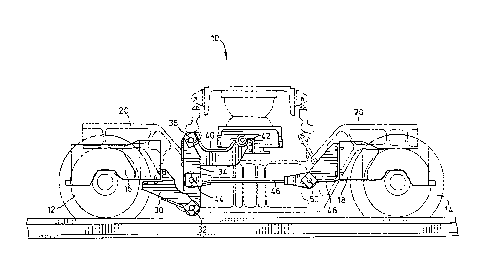Une partie des informations de ce site Web a été fournie par des sources externes. Le gouvernement du Canada n'assume aucune responsabilité concernant la précision, l'actualité ou la fiabilité des informations fournies par les sources externes. Les utilisateurs qui désirent employer cette information devraient consulter directement la source des informations. Le contenu fourni par les sources externes n'est pas assujetti aux exigences sur les langues officielles, la protection des renseignements personnels et l'accessibilité.
L'apparition de différences dans le texte et l'image des Revendications et de l'Abrégé dépend du moment auquel le document est publié. Les textes des Revendications et de l'Abrégé sont affichés :
| (12) Brevet: | (11) CA 1300431 |
|---|---|
| (21) Numéro de la demande: | 1300431 |
| (54) Titre français: | TRINGLERIE LONGITUDINALE DE DIRECTION, POUR BOGIE DE VEHICULE FERROVIAIRE, AVEC CHAPES INTER-ESSIEUX |
| (54) Titre anglais: | LONGITUDINAL STEERING LINKAGE FOR TRUCK WITH INTERAXLE YOKES |
| Statut: | Durée expirée - après l'octroi |
| (51) Classification internationale des brevets (CIB): |
|
|---|---|
| (72) Inventeurs : |
|
| (73) Titulaires : |
|
| (71) Demandeurs : |
|
| (74) Agent: | SMART & BIGGAR LP |
| (74) Co-agent: | |
| (45) Délivré: | 1992-05-12 |
| (22) Date de dépôt: | 1988-11-03 |
| Licence disponible: | S.O. |
| Cédé au domaine public: | S.O. |
| (25) Langue des documents déposés: | Anglais |
| Traité de coopération en matière de brevets (PCT): | Non |
|---|
| (30) Données de priorité de la demande: | S.O. |
|---|
CANADA
Title: LONGITUDINAL STEERING LINKAGE
FOR TRUCK WITH INTERAXLE YOKES
INVENTOR: ROY E. SMITH
PETER E. TIMAN
ABSTRACT OF THE DISCLOSURE
This invention applies the linkage connected
between the interaxle yokes of a truck and a railroad
vehicle car body so as to create radially steered alignment
of wheelsets on circular curves without reference to the
truck frame. Forces exchanged between the wheelsets and the
car body are essentially longitudinal and no significant
lateral forces are created on the truck frame or car body
from the steering action. The steering linkage utilizes the
longitudinal component of relative motion of a point on the
car body with reference to the vehicle truck to cause rela-
tive pivotal movement of the interaxle yokes thereby guiding
the wheelsets to a radial alignment. Radial alignment is
achieved by suitable proportioning of the links of the
mechanism.
Note : Les revendications sont présentées dans la langue officielle dans laquelle elles ont été soumises.
Note : Les descriptions sont présentées dans la langue officielle dans laquelle elles ont été soumises.

2024-08-01 : Dans le cadre de la transition vers les Brevets de nouvelle génération (BNG), la base de données sur les brevets canadiens (BDBC) contient désormais un Historique d'événement plus détaillé, qui reproduit le Journal des événements de notre nouvelle solution interne.
Veuillez noter que les événements débutant par « Inactive : » se réfèrent à des événements qui ne sont plus utilisés dans notre nouvelle solution interne.
Pour une meilleure compréhension de l'état de la demande ou brevet qui figure sur cette page, la rubrique Mise en garde , et les descriptions de Brevet , Historique d'événement , Taxes périodiques et Historique des paiements devraient être consultées.
| Description | Date |
|---|---|
| Inactive : Périmé (brevet sous l'ancienne loi) date de péremption possible la plus tardive | 2009-05-12 |
| Accordé par délivrance | 1992-05-12 |
Il n'y a pas d'historique d'abandonnement
| Type de taxes | Anniversaire | Échéance | Date payée |
|---|---|---|---|
| TM (catégorie 1, 6e anniv.) - générale | 1998-05-12 | 1998-04-17 | |
| TM (catégorie 1, 7e anniv.) - générale | 1999-05-12 | 1999-04-09 | |
| TM (catégorie 1, 8e anniv.) - générale | 2000-05-12 | 2000-02-18 | |
| TM (catégorie 1, 9e anniv.) - générale | 2001-05-14 | 2001-03-15 | |
| TM (catégorie 1, 10e anniv.) - générale | 2002-05-13 | 2002-04-15 | |
| TM (catégorie 1, 11e anniv.) - générale | 2003-05-12 | 2003-04-17 | |
| TM (catégorie 1, 12e anniv.) - générale | 2004-05-12 | 2004-04-16 | |
| TM (catégorie 1, 13e anniv.) - générale | 2005-05-12 | 2005-04-25 | |
| TM (catégorie 1, 14e anniv.) - générale | 2006-05-12 | 2006-04-24 | |
| TM (catégorie 1, 15e anniv.) - générale | 2007-05-14 | 2007-04-23 | |
| TM (catégorie 1, 16e anniv.) - générale | 2008-05-12 | 2008-04-22 |
Les titulaires actuels et antérieures au dossier sont affichés en ordre alphabétique.
| Titulaires actuels au dossier |
|---|
| BOMBARDIER INC. |
| Titulaires antérieures au dossier |
|---|
| PETER E. TIMAN |
| ROY E. SMITH |